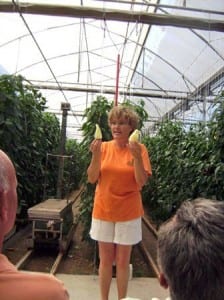ON two occasions in 2010 we organised visits to the Clisol greenhouses close to where we live in Almerimar in the province of Almería. On each occasion we had a group of around 20 readers of our website visit the greenhouses for around 2.5 – 3 hours.
This article is a summary based on information gathered on those visits. Please note that I do not wish to go into too much detail in the article as I feel it would spoil things for when other people make a visit to the greenhouses.
Clisol organise visits to their greenhouses to educate people about how the greenhouses are used. As agriculture and in particular ‘plasticulture’ is important in the province of Almería I feel it is good for people to see and understand what happens in the greenhouses.
Before I start I realise that many people think that the plastic greenhouses are a blot on the landscape. I know they are ugly but they do play a big part in the economy of Almería and Andalucía.

Lola Gómez Ferrón
On both visits our guide was Lola Gómez Ferrón who gave us a fascinating insight into how the greenhouses are run.
Lola and her family come from Balerma (close to Almerimar) and have been involved in the greenhouse industry for over 40 years. She appeared to know everything you would ever want to know about the plastic greenhouses.
Lola normally conducts the visits in Spanish but she can also speak English. On both visits most of our groups were non-Spanish so we had the tours in English.
Arrival
On arrival Lola greeted us all in the car park and explained that we had driven through a trough of disinfectant on the way in for safety reasons to protect the crops.
She then explained that the visits would consist of three parts. There were visits to traditional style greenhouses, visits to hydroponic greenhouses then a trip to the delicatessen.
Traditional style greenhouses
The first greenhouse we went in on both visits was a traditional style greenhouse. On both occasions the greenhouse was growing Holland style cucumbers (the smoother ones rather than the more typical Spanish knobbly ones).
On one occasion the cucumbers were very small and on the other occasion they were almost ready to be picked. Amazingly the small cucumber on the plant in the photo was ready to pick within around 20 days.
Here in the tradition style greenhouses we leaned a lot about the history of the greenhouses. Also how Lola used to work for her parents in greenhouses from when she was very young. Plus she described how she still gets her children to help her in the greenhouse in their holidays from school.
We found out that only 2.7% of the land in the province of Almería is given over to greenhouses. Most of this land is by the sea rather than close to the mountains as the temperatures are generally better nearer the sea.
Topics covered included:
- The effect of environmental factors such as temperature and relative humidity in the greenhouses
- Methods of irrigation
- The move from chemical to biological pest control systems
- How many crops a year you can grow
- Rates of growth for crops at different times of year
- Variations in price for crops throughout the year
- Crop rotation
- Soil structure
- How overnight temperatures are maintained
- Water consumption
- Patterns of flight of ´bad´ insects
Hydroponic greenhouses
On each occasion after the traditional style greenhouse we moved on to visit two of the more modern hydroponic greenhouses. Here we saw an empty greenhouse that was ready for planting to happen; one with small plants in troughs the size of window boxes and one with larger plants.
On the way in we went through a double-door portal area where you enter and close the outside doors before opening the inner ones. This area had blue and yellow flysheets to collect ‘bad’ insects.
Inside the main part of the hydroponic greenhouses we leaned about:
- The growing materials (e.g. coconut fibre being the natural growing material of the future)
- The use of bees and bumble bees to pollinate those plants that required pollination
- ‘Good’ insects – spiders and wasps used to control the ‘bad’ insects including some quite graphic descriptions of the way very small wasps and barley plants are used to control aphids
- Water recycling
- Computer control of the greenhouse
- Techniques and equipment for gathering crops including a very neat rail-based system with adjustable height control that can be used for planting and gathering crops.

Transplanting tomato plants
On one of the visits we had 4 children in the group. Lola got them to transplant some tomato plants that they could take home and try to grow for themselves.
Long pumpkins and rose-like hot mini peppers
Close to the end of one of the visits Lola pointed out a couple of plants that she appeared to be growing for fun. One was growing long pumpkins and the other rose-like very hot small peppers.
One tip I can provide is not to try inserting contact lenses after taking the seeds out of the hot small peppers. I did this before golf one morning and even though I washed my hands thoroughly before touching the contact lenses it still felt like I was putting acid into my eyes.
I had to play golf in glasses rather than lenses so at least I had a good excuse for my bad round that day.
Other facts
Here are a few other facts I picked up on the visits:
- Mice like cucumber plant seeds but do not like the smell of garlic. So some growers leave cucumber plant seeds to soak in garlic flavoured water prior to planting them to stop the seeds being eaten by mice.
- Lola’s recommendations are red peppers for cooking and yellow peppers for eating raw.
- Small plants cannot drink water recycled from hydroponic greenhouses so it is best to have at least two hydroponic greenhouses in use at any time. One greenhouse should contain small plants and the second greenhouse containing larger ones. That way the fresh water used on the smaller plants can be recycled and used again to feed the larger plants.

Clisol delicatessen
On each occasion, after we had finished the trip around the greenhouses we went to the Clisol delicatessen which is on-site close to the greenhouses. When in the delicatessen we had the opportunity to try lots of the produce including different types of tomatoes, tomate frito and cucumber drizzled with honey.
In the delicatessen you can purchase fresh produce grown in the greenhouses along with chocolate, hand creams and other products from the Alpujarras. Plus a book for children about the greenhouses published in English, German and Spanish.
We also saw pictures of the greenhouses when school visits were taking place including people dressed as giant vegetables to entertain the groups of up to 90 children.







